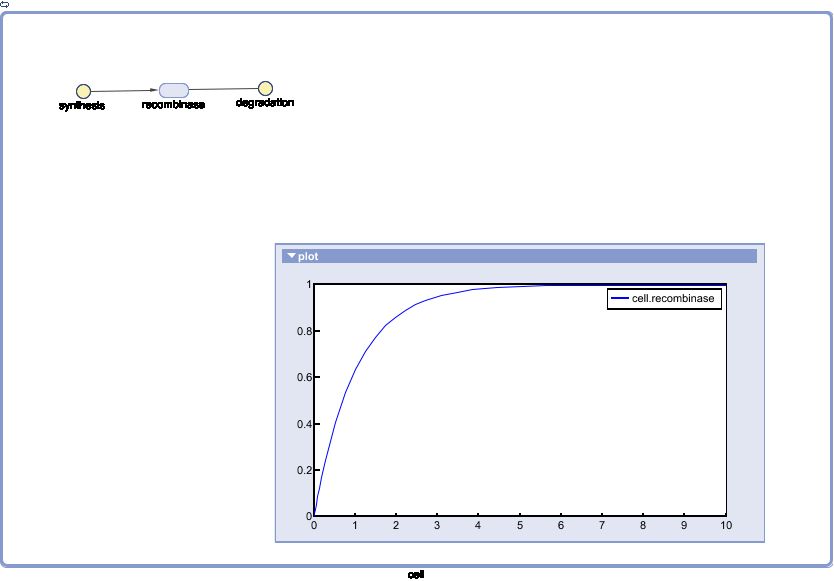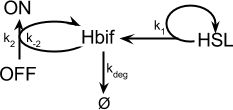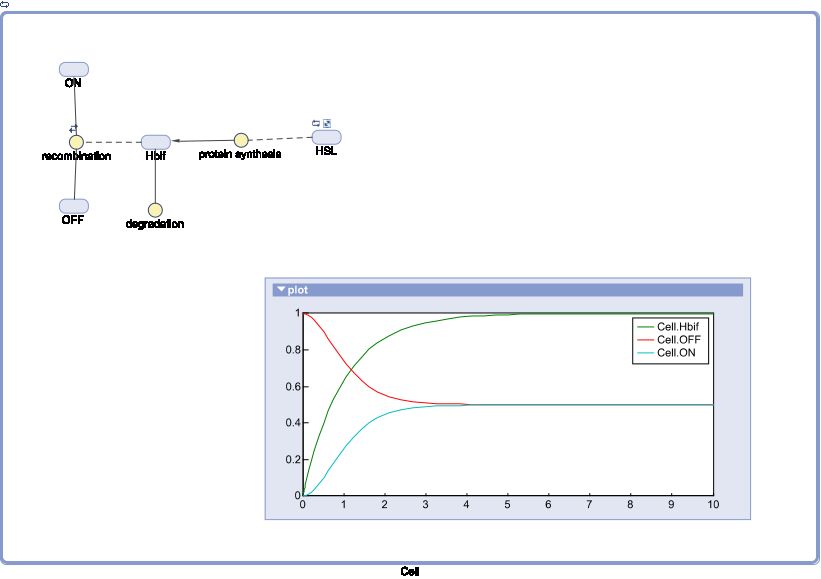Team:Michigan/Modeling
From 2013.igem.org
(→7. Optimization) |
|||
| Line 182: | Line 182: | ||
=Future Directions= | =Future Directions= | ||
Data! | Data! | ||
| - | |||
| - | |||
| - | |||
| - | |||
| - | |||
| - | |||
| - | |||
| - | |||
| - | |||
| - | |||
| - | |||
| - | |||
| - | |||
| - | |||
| - | |||
| - | |||
Revision as of 01:51, 28 September 2013
Contents |
Introduction
Switch modeling
• produce both states of switch
• use model to optimize switch
Mass action modeling
Definition
• differential equations
• each equation is a sum of rates
• each rate is proportional to each of its reactants
Benefits
• can minimize assumptions
• already used in chemical rate equations
• standardizes equations:
• x is the species vector
• a is an amount of rates changing x
• b is a rate constant
• c is a number of different species involved
• d is a species involved
• e is a number of each species involved
• f is a number of species d involved
• g is a highest species involved
• l is a rate order
• m is the highest number of rates involved
• n is the number of species
Analytical modeling
• benefits
• given parameters, it precisely predicts behavior
• accurately predicts the data needed to determine parameters (unlike numerical analysis)
• allows avoidance of numerical errors like rounding
• naturally standardized
ERSESCO Algorithm
The ERSESCO algorithm the Michigan team developed provides a clearly defined method of using symbolic analysis on systems. The algorithm has seven major steps:
1. Equation
Formulate the system into a system of differential equations.
2. Reduction
Apply constraints, boundary conditions, and conservation laws to reduce the system of equations to fewer variables.
3. Solution
Solve the reduced system of equations, if possible.
4. Equilibration
Find the steady states of the system by setting differential equations to zero and solving for critical points.
5. Stabilization
Evaluate the Jacobian matrix of the system of equations at each critical point and find the corresponding eigenvalues. Eigenvalues with a negative real part are stable critical points.
6. Calibration
Solve for the parameters of the system of equations in terms of the system's initial, steady state, time-dependent variables. This step allows the system parameters to be easily characterized using experimental data.
7. Optimization
Optimize the steady state, eigenvalues, parameters, or other desired quantity by equating the derivative of that quantity with respect to each of the system's parameters with zero. Solving these equations gives the optimization conditions for that quantity.
SimBiology
• is a MatLab package provided to iGEM teams
• provides a numerical approximation
• easily creates from a diagram
Model of Recombinase Expression
The Recombinase Expression Model describes the synthesis and degradation of any protein produced at a relatively constant rate. Here, the model is used in particular to describe the synthesis and degradation reaction rates ksyn and kdeg of recombinases in the cell. The model also predicts the recombinase concentration.
Model of the Switch
The Switch Model describes how the switch equilibrates when the concentrations of the recombinases FimE and Hbif approach constant values. This model assumes that each recombinase catalyzes a one way reaction. This model predicts the degree of cooperativity n and m in the binding reaction of the recombinase to DNA for FimE and Hbif, respectively. Furthermore, this model predicts the forward catalysis rate constants, kF and KH, for FimE and Hbif.
Model of Inducible Hbif
The Inducible Hbif Model describes how the switch flips when acted upon by the Lux/HSL-controlled expression of Hbif. In this model, [HSL] represents the concentration of the species HSL:pLux:LuxR, the complex that promotes the expression of Hbif. In this model [HSL] is a function of pLux and LuxR expression levels in the cell, the amount of HSL added, and the fractional occupancies at the complexation equilibrium. It can be assumed that this complexation reaction happens instantaneously with respect to the slow, rate-limiting translation step of Hbif. This model predicts the rate k1 of Lux-induced expression of Hbif, the degradation rate kdeg of Hbif, the forward and reverse rates k2 and k-2 of Hbif catalysis on the switch, and the equilibrium constant K2 for the switch when acted upon by Hbif.
Expression Model
Equation:
Reduction: None
Solution:
Equilibration:
Stabilization:
Calibration:
Optimization:
SimBiology:
Switch Model
Equation:
Reduction:
Solution:
Equilibration:
Stabilization:
Calibration:
Optimization:
SimBiology:
Inducible Hbif Model
Equation:
Reduction:
Solution:
Equilibration:
Stabilization:
Calibration:
Optimization of Hbif:
Optimization of ON:
SimBiology:
Inducible Hbif Model Derivation
Future Directions
Data!
| Home | Team | Official Team Profile | Project | Parts Submitted to the Registry | Modeling | Notebook | Safety | Attributions |
|---|
 "
"


























